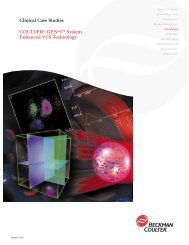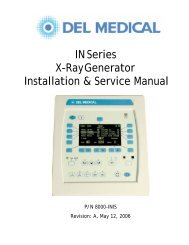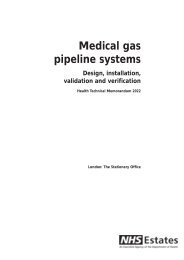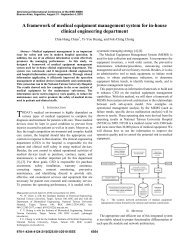Electrosurgery Self-Study Guide
Electrosurgery Self-Study Guide
Electrosurgery Self-Study Guide
Create successful ePaper yourself
Turn your PDF publications into a flip-book with our unique Google optimized e-Paper software.
<strong>Electrosurgery</strong> <strong>Self</strong>-<strong>Study</strong> <strong>Guide</strong><br />
Electrosurgical<br />
Accessories<br />
Electrosurgical units are only part of the electrosurgical<br />
system. Another, integral, part is the accessories. These<br />
include active electrodes, holsters, and patient return<br />
electrodes (grounding pads).<br />
Active Electrodes<br />
Active electrodes deliver concentrated current to the<br />
target tissue. There is a wide assortment of active<br />
electrodes available for both bipolar and monopolar units.<br />
Active electrode pencils or forceps may be controlled by<br />
handswitches or foot pedals. Pencil tips are available in<br />
needles, blades, balls, and loops (Figure 30). Some active<br />
electrodes are a combined suction and coagulation<br />
instrument. As minimally invasive surgery has gained<br />
popularity, active laparoscopy electrodes have also been<br />
developed. They are available as disposable and reusable<br />
products.<br />
Figure 30 – Active Electrodes<br />
In 1991 an electrosurgical device was developed for use<br />
with the ultrasonic surgical aspirator (Figure 31). The<br />
ultrasonic surgical aspirator handpiece attaches to a<br />
command console. When in operation, the ultrasonic<br />
handpiece vibrates at a frequency of 23,000 times per<br />
second. That frequency is above the range of human<br />
hearing, thus the name ultrasonic. The device does not<br />
emit sound waves or light waves. Its vibrating tip works by<br />
contacting tissue. When it does, fragmentation occurs.<br />
16<br />
By itself, the ultrasonic handpiece provides no hemostasis.<br />
When an electrosurgical module is added to the<br />
handpiece, the surgeon is able to fragment, cut or<br />
coagulate tissue, simultaneously or independently.<br />
Figure 31 – Ultrasonic Surgical Aspirator Handpiece with<br />
Electrosurgical Module Attachment<br />
Holsters<br />
Holsters are a vital safety component of the<br />
electrosurgical system. When active electrodes are not in<br />
use, they should be placed in holsters where they will be<br />
easily accessible and visible to the surgical team. They<br />
should be of the<br />
type recommended by the manufacturer for use with<br />
electrosurgical active electrodes, and should meet<br />
standards for heat and fire resistance. Patient safety can<br />
be threatened by the use of pouches and other makeshift<br />
holsters not intended for use with electrosurgery active<br />
electrodes.<br />
Patient Return Electrodes<br />
Patient return electrodes, or grounding pads, collect the<br />
monopolar current that has entered the patient and allow<br />
it to be safely removed and returned to the generator.<br />
There are many types of patient return electrodes used,<br />
ranging from metal plates to dual section pads. Reusable<br />
metal plates are made of stainless steel and fit under the<br />
patient. With such plates, conductive gel must be used to<br />
improve the conductive plate/patient interface. The<br />
quality of contact depends on gravity and the amount of<br />
gel used. A disposable version of this plate is also used. It<br />
is made of cardboard and covered with foil. Neither type<br />
plate conforms to body contours and effectiveness may<br />
vary. Pre-gelled, disposable foam pads adapt well to body










